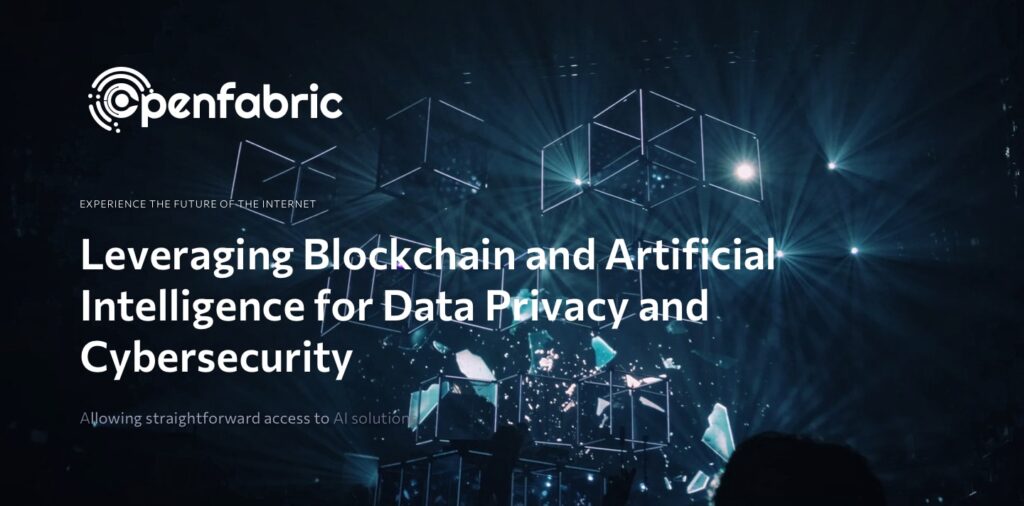
September 10, 2021 7 minutes read
Leveraging Blockchain and AI for Data Privacy and Cybersecurity

In recent times, after the emergency of blockchain technology and AI, there have been some concerns regarding the privacy of user’s data. This was followed by major data breaches recorded. However, even within the chaos there have been very major breakthroughs in using AI for data privacy and cybersecurity to combat these issues.
Active seeking of solutions has led to the development of cybersecurity advancements and new legislation. They are coupled with systems powered by blockchain and artificial intelligence. This promises to usher in a new era of automated, transparent and secured applications for people to easily trust.
Indeed, the last few years have seen a massive increase in high-level security breaches. This shows the need for better privacy and security controls. It is especially needed when users’ personal data is involved.
That is why in this article, we are going to discuss what these cyber security systems can potentially do and how Openfabric’s decentralized AI solutions can help bring about this needed change.
Let’s dive in.
Historical Background of AI in Privacy and Cybersecurity
In the past, data breaches or its threat was not as common as it is these days. However, the exponential increase in the amount of data being generated and collected has resulted in a higher risk of data breaches.
But it’s not all bad
Thanks to this increase in generated data, businesses have been able to create services personalized to the level of individual users. Typically centralized organizations such as Amazon, Google, and Facebook are examples of such businesses. However, this makes their central data repositories highly sought-after targets for cybercriminals.
Large-scale breaches such as the Equifax data breach of 2017 was a turning point in cyber security. This affected over 140 million customers forcing the industry to look for alternative ways to store and manage sensitive data.
A different approach was discovered for storing and managing data. Together, the application of blockchain and AI for data privacy and cybersecurity emerged. They can help protect and secure personal data by:
- Providing users with control over how their personal data is used.
- Preventing the impact of cyber threats
- Ensuring that private data and the models built on that data are reliable.
In response to the rising number of privacy breaches and cybersecurity threats, we made efforts to address these issues. We set up efforts such as privacy regulations.
Brief Overview of What Data Is
We’ve been talking about data and data breaches but we have to know a little about data to adequately understand the severity of a data breach.
Data basically consists of a person’s internet records such as biometrics, browsing habits, social security numbers, addresses, birthdays, and more. Some data are particularly known as personal data. Personal data consists of data on the following:
- Individual records
- Family records
- Credit scores and financial records
- Business leads, investors, and more.
Private servers typically protect such data in encrypted and/or anonymized form. Individual users can still be linked to this data, unfortunately.
Significance of data
Many of today’s most recognizable names in the tech space have built their empires upon user’s personal data. The power to preserve the integrity of this type of personally identifiable information (PII) is a strategic requirement for many organizations.
Privacy Regulations to Combat Privacy Attacks
To combat these attacks, we formulated new regulations such as the General Data Protection Regulation (GDPR) and the California Privacy Rights Act (CPRA), which expanded on the 2018 California Consumer Privacy Act (CCPA). In 2016, the EU passed both regulations to address these threats. It generally give users the right to:
- Know what kinds of personal data of theirs is being collected.
- Be aware of whether your data is ever sold or disclosed to others, and if so, to whom.
- Refuse the sale of their personal data.
- Access their personal data.
- Request a business to delete their personal data.
- Not face discrimination for exercising their right to privacy.
These types of privacy laws can improve how companies protect consumer data. However, implementing the systems and practices that can help them do that can be challenging.
This is where blockchain and distributed ledger technology (DLT) can help with compliance.
Data breaches are still on the rise
Risk Based Security’s 2020 Year-End Report revealed a steep increase of over 140% in compromised data records from 2019, with a total of over 37 billion records in 2020. Unauthorized access to private databases allows malicious actors to gain access to sensitive personal information like passwords and credit card numbers. The subsequent issues that arise, such as fraud and identity theft, cost society billions of dollars annually to address. In most cases, such issues take months or years per case.
As the collection of data increases, the frequency, complexity, and impact of attacks also increase. Therefore, we need to rethink how we secure data. Let’s think blockchain technology and artificial intelligence for data privacy and cybersecurity.
However, despite significant advances in software applications and security protocols, privacy breaches are all too common and on the rise.
Using Blockchain and AI for Privacy and Cybersecurity
Blockchain
One of the most important benefits of blockchain-based solutions is that they allow organizations to share data in ways that were not previously possible. This opens up new ways to collaborate, improve operational efficiencies, and tap into new revenue streams.
It is of the utmost importance for blockchain architects to put the following into consideration to secure private data in blockchain applications:
- Who can read and write transactions to a shared ledger
- The process of broadcasting, authenticating, and storing data and transactions
- Decentralized identities: This refers to when individuals have ownership rights over their data that relate to identity.
Private databases have the ability to store personal data. Users can then use blockchain-stored pointers to interact with or verify data. Such solutions involving AI and blockchain cybersecurity use cases are seen in licensing, insurance, and healthcare.
Individuals are able to maintain privacy and control over their data while still gaining access, thanks to the use of zero-knowledge proofs. One can use them to mathematically verify the truth of a statement or condition without disclosing any data.
Artificial Intelligence
Currently, a wide range of disciplines use AI for data privacy and cybersecurity, including speech and facial recognition, medical diagnosis, financial modeling, and more. Organizations can train AI applications using data without the need to possess or manage said data. This reduces the exposure level of the organizations and stakeholders who provide that data.
Some of the ways that AI can improve security and safeguard privacy are:
- Detecting malicious attacks to enhance system security.
- Allow users to decide what data they want to share using smart contracts that enforce permissioning.
- Automatically extracting insights and cleaning large datasets.
- Tapping into a wider range of data types and building better, more realistic, and more authentic AI models.
Blockchain cybersecurity use cases
Industries and verticals across numerous sectors are utilizing blockchain and AI for data privacy and cybersecurity.
For example, medical researchers have gathered intelligence on virus transmission and used AI models to guide decision-making. Smart cities are using embedded sensors and edge devices to empower smart cargo tracking, resource allocation, real-time power generation and distribution
Blockchain architectures can make it easier and more cost-effective to rent or share transportation and homes.
Use cases of AI for Data Privacy and Cybersecurity
AI on the other hand, can be used to:
- Process license applications
- Generate contracts
- Dynamically change insurance or utility fees based on usage.
- Conserve energy by switching off appliances or systems, such as HVAC equipment, when they are not needed.
- Reducing intermediaries to facilitate cheaper funds transfers.
The list goes on and on. Fortunately, there are new, innovative ways we can now share and combine data that were never before possible. What we need now is a better way to create, disseminate, and help monetize the AI applications that can make all of the changes above possible.
The question on your mind is, “how can this be done?”
Openfabric’s Blockchain-Powered Artificial Intelligence Platform
Here you have it!
Openfabric envisions a world in which everyone has quick, easy, and low-cost access to the data and algorithms needed to create better services. At its core, the platform embodies decentralization, security, scalability, interoperability, and ease-of-use. Innovators have crafted this platform to help anyone who wishes to tap into the vast potential of AI algorithms and applications. In addition, there’s easy access to these AI algorithms and applications.
Benefits of Openfabric AI for privacy and cybersecurity
Openfabric AI gives users an easy way to create products, services, and solutions of their own. It also has the potential to power a new wave of innovation and advancement.
The platform secures all personal data that could be used by users, thus, providing them a hassle-free experience. Our decentralized technology also allows users to monitor the utilization and purpose of their data.
We put the “transparent” in “transparency”!
Conclusion
Basic internet access drove many of the most important technological innovations of the last 20 years. Our team envisions the next decade or two as by groundbreaking technological advancements, all fueled by the Openfabric AI platform.
To learn more about how Openfabric is creating a seamless, integrated, and hassle-free artificial intelligence access platform for all, visit our website.
You can also check out our roadmap on our Twitter account.

